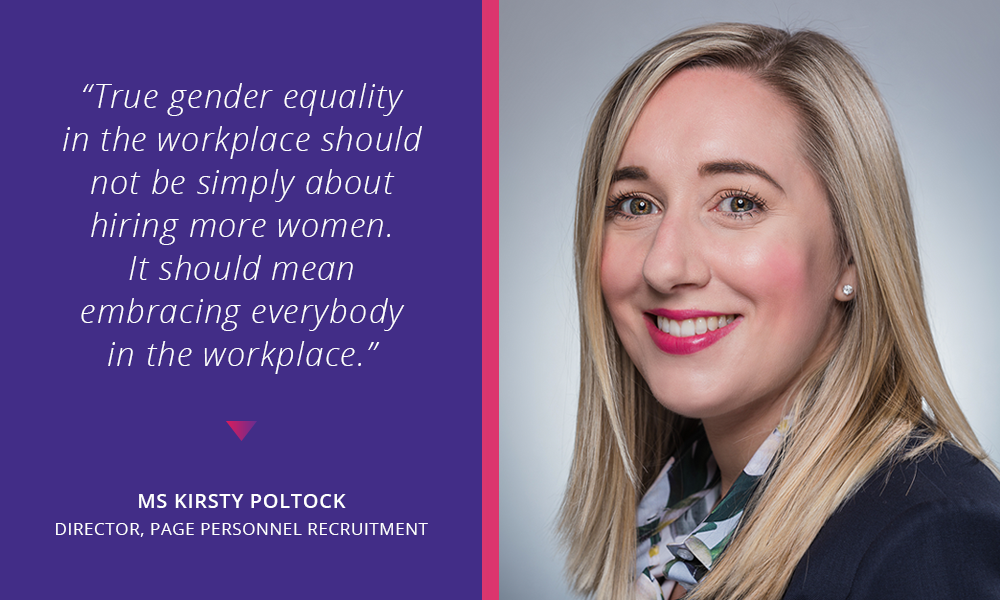In 2016, Singapore’s female labour force participation rate stood at 60.4%, up from 54.3% a decade before. However, while some progress has been made towards gender parity, barriers remain. For example, there is a wider gender gap in workforce numbers for women in their 30s and beyond in Singapore, mainly due to family commitments (children) as well as taking care of elderly family members.
Studies reveal that gender-diverse companies report higher revenues. Reasons for this include the fact that men and women bring different ideas to the table, have different approaches to problem-solving, are able to service diverse clientele, and tend to attract and retain other talented men and women.
Yet there are some companies in Singapore especially in particular industries such as technology, fintech and life sciences where it is a struggle to attract women. For instance, a 2014 manpower survey by the Infocomm Development Authority of Singapore showed only a 30% female representation in Singapore’s tech sector. But this meagre number is not unique to Singapore — globally about a third of employees at tech giants such as Amazon, Facebook, Google and Microsoft are women.
Then there are certain sectors such as healthcare that may have a solid representation of women in entry- to mid-level roles, but see these numbers dwindling closer to the top.

So just how can companies in Singapore better bridge the gender divide? Ms Kirsty Poltock, Director, Page Personnel Recruitment shares some tips on how more companies in Singapore can alleviate their struggles to hire more women in the workplace:
1. Lead from the top
While many companies have come a long way in closing the gender gap, true gender equality in the workplace should not be simply about hiring more women. “It should mean creating a truly inclusive working environment by embracing everybody in the workplace, men and women, listening to employees regardless of their gender and incorporating their ideas and needs into the fabric of your work culture,” says Ms Poltock. Doing this requires an active commitment from a company’s leadership team who must walk the talk when it comes to the way they treat staff — no matter their gender.
One way to address this is by having and aligning well-defined values in company policies, attitudes and work culture, ensuring these are emphasised throughout the hiring process. It allows companies to create a more diverse team, where equal opportunities are given to all who deserve it.

2. Ensure your hiring process is inclusive
Inclusivity starts at the beginning of the hiring process. Implicit bias towards or against women can be unknowingly included in your company’s job descriptions, interview questions, interviewers’ attitudes and more.
Does your job description unwittingly use gender-specific pronouns? Try using “you” or “s/he” for more gender inclusivity, and use neutral and specific job titles such as “cybersecurity specialist” rather than “hacker”, or “mobile developer” rather than “mobile ninja”. Do also separate required skills from nice-to-have skills in your job applications.
Research has shown that men apply for jobs when they meet only 60% of the qualifications, but women apply only if they have 100% of them. Finally, at interviews, consider asking women for more details about their accomplishments as they may be more likely than their male counterparts to downplay their success.

3. Encourage shared parental responsibility and flexi-work
To help achieve a better work-life balance and encourage more women to stay in the workforce, Singapore has implemented several enhanced maternity benefits and leave schemes for working parents. For example, a working father is now able to share a portion of his wife’s 16 weeks of maternity leave.
In addition, the government is encouraging more flexible workforce policies in the workplace (currently, about 47% of companies in Singapore offer full-time flexible work arrangements). Ms Poltock notes that employers, including small and medium enterprises (SMEs), suffer an impact when staff leaves an inflexible workplace — “not only do you lose valuable employees, the knowledge they take with them is challenging to replace and it starts the whole hiring process again, which can be both costly and time-consuming,” she says.
Flexible work, she adds, means that women don’t need to retreat from the workforce when they are required to care for their families. “More often than not, when employers are willing to be flexible with their workplace policies, employees are willing to give back,” says Ms Poltock.
One thing companies have to bear in mind when encouraging flexi-work though is when it comes to the measurement of staff performance and results. Team members and leaders need to agree and be aligned on what needs to be achieved and how this contributes to the company’s overall objectives.















